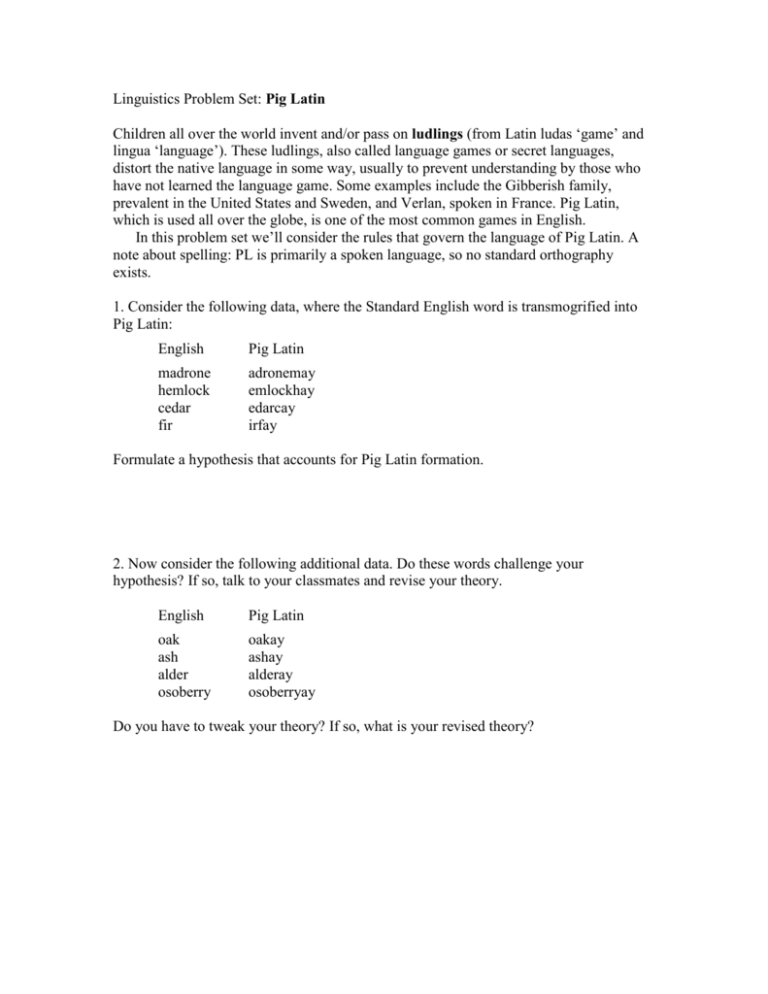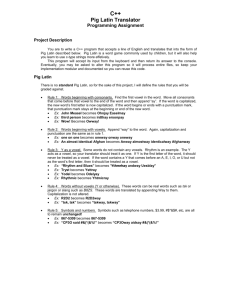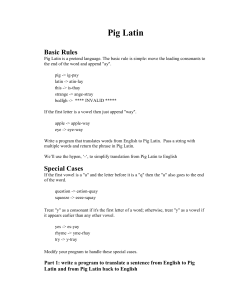Linguistics Problem Set: Pig Latin
advertisement

Linguistics Problem Set: Pig Latin Children all over the world invent and/or pass on ludlings (from Latin ludas ‘game’ and lingua ‘language’). These ludlings, also called language games or secret languages, distort the native language in some way, usually to prevent understanding by those who have not learned the language game. Some examples include the Gibberish family, prevalent in the United States and Sweden, and Verlan, spoken in France. Pig Latin, which is used all over the globe, is one of the most common games in English. In this problem set we’ll consider the rules that govern the language of Pig Latin. A note about spelling: PL is primarily a spoken language, so no standard orthography exists. 1. Consider the following data, where the Standard English word is transmogrified into Pig Latin: English Pig Latin madrone hemlock cedar fir adronemay emlockhay edarcay irfay Formulate a hypothesis that accounts for Pig Latin formation. 2. Now consider the following additional data. Do these words challenge your hypothesis? If so, talk to your classmates and revise your theory. English Pig Latin oak ash alder osoberry oakay ashay alderay osoberryay Do you have to tweak your theory? If so, what is your revised theory? It turns out that Pig Latin has dialects. When words start with vowels, there are several ways to form the PL word. Here are four of them: (a) eat (b) art (c) honest Dialect 1 eat-may art-may onest-may Dialect 2 eat-hay art-hay onest-hay Dialect 3 eat-way art-way onest-way Dialect 4 eat-ay art-ay onest-ay Dialect 1: If the word begins with a vowel, use /m/ as the default consonant before /ay/. Dialect 2: If the word begins with a vowel, use /h/ as the default consonant before /ay/. Dialect 3: If the word begins with a vowel, use /w/ as the default consonant before /ay/. Dialect 4: If the word begins with a vowel, simply say /ay/ at the end of the word. So, Pig Latin, like “real” languages, has dialects. The speakers of a language, or a Pig Latin dialect, often guard their own as the “best” and “right” way, though those attitudes are determined socially, not linguistically. Each dialect’s linguistic rules are equally logical, equally systematic, and equally effective. The variations in Pig Latin illustrate that one dialect is not linguistically better or worse than another. 3. Finally, consider these data: English Pig Latin tree shrub spruce eetray ubshray ucespray Does your theory account for these data? If not, what is your revised theory? Ongratulationscay! Ou’reyay ellway onay ethayayway otay ecomingbay uentflay inay Igpay Atinlay! Eepkay onay ethey ooklay orfay ounterexamplescay. Based on a talk given by Kristen Denham, professor of linguistics at Western Washington University, at the annual convention of the National Council of Teachers of English in Pittsburgh, PA, November 19, 2005: “Ludlings teach language diversity and change: From Pig Latin to Ubby Dubby.”









